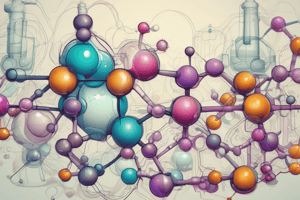Podcast
Questions and Answers
What is the general term for compounds with a carbonyl group bonded to at least one hydrogen atom and one alkyl or aryl group?
What is the general term for compounds with a carbonyl group bonded to at least one hydrogen atom and one alkyl or aryl group?
- Aldehydes (correct)
- Ketones
- Carboxylic acids
- Esters
Which reaction involves the self-condensation of an aldehyde or a ketone followed by dehydration to give α,β-unsaturated carbonyl compound?
Which reaction involves the self-condensation of an aldehyde or a ketone followed by dehydration to give α,β-unsaturated carbonyl compound?
- Friedel-Crafts acylation
- Aldol condensation (correct)
- Cannizzaro reaction
- Esterification
Which of the following is formed when an aldehyde undergoes self-oxidation and reduction processes simultaneously in the presence of concentrated alkali?
Which of the following is formed when an aldehyde undergoes self-oxidation and reduction processes simultaneously in the presence of concentrated alkali?
- Carboxylic acid
- Alcohol
- Ester (correct)
- Acid chloride
Which functional group is present in acid chlorides, but absent in esters and amides?
Which functional group is present in acid chlorides, but absent in esters and amides?
Flashcards
Aldehyde
Aldehyde
A compound with a carbonyl group (C=O) bonded to at least one hydrogen atom and one alkyl or aryl group.
Aldol Condensation
Aldol Condensation
A reaction where two aldehydes or ketones react to form a larger molecule with a double bond. It involves self-condensation followed by dehydration.
Cannizzaro Reaction
Cannizzaro Reaction
A reaction where an aldehyde molecule reacts with itself, forming an ester and an alcohol. This happens in the presence of a strong base.
Acyl Chloride
Acyl Chloride
Signup and view all the flashcards
Study Notes
Carbonyl Compounds
- General term for compounds with a carbonyl group (C=O) bonded to at least one hydrogen atom and one alkyl or aryl group is aldehydes.
- If the carbonyl group is bonded to two alkyl or aryl groups with no hydrogen, it is referred to as a ketone.
Reaction of Aldehydes and Ketones
- The reaction involving the self-condensation of an aldehyde or ketone, followed by dehydration, produces α,β-unsaturated carbonyl compounds.
- This reaction is commonly known as aldol condensation.
Special Reactions of Aldehydes
- When an aldehyde undergoes simultaneous self-oxidation and reduction in the presence of concentrated alkali, it leads to the formation of a geminal diol or hydrate.
Functional Groups in Organic Compounds
- Acid chlorides are characterized by the presence of a carbonyl group (C=O) combined with a chlorine atom (Cl).
- This functional group is absent in esters and amides, which contain carbonyl groups bonded to other groups (like alkoxides in esters or amine groups in amides) instead of a chlorine atom.
Studying That Suits You
Use AI to generate personalized quizzes and flashcards to suit your learning preferences.




